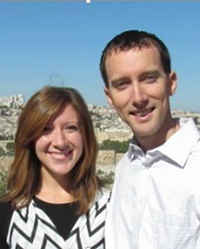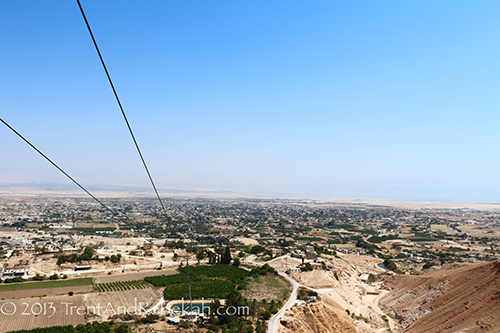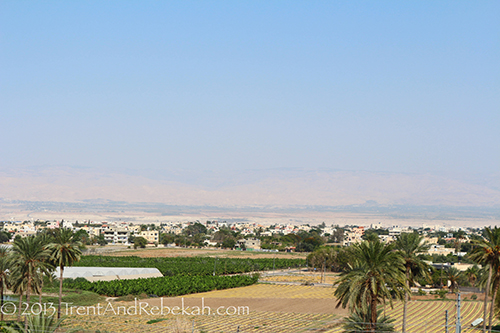

by Trent and Rebekah Dutton
Synopsis: Trent and Rebekah lead us on an excursion to Jericho, "the City of Palm Trees" and its environs, which provide a visually-striking backdrop for multiple biblical episodes.
Tel es-Sultan, as the site of biblical Old Testament Jericho, has been excavated by some of the biggest names in Biblical Archaeology from previous generations. It has also been a site of flashy archaeological debate for many years, concerning its stratigraphic layers, and what they mean for the biblical text. We will not delve into that debate here, but rather look up and outside of the archaeological hole to the surrounding landscape.
The photo of the Jordan Valley was shot from the "Mt. of Temptation," just west of Jericho (See Image 1). As the name implies, this is the traditional location where Jesus was "tempted" by the devil (Matt. 4). A Greek Orthodox monastery sits atop, or rather, clings to the side of the mountain, to honor this tradition (which has no relation to Jericho's Old Testament history). One can see the setting (albeit through the desert summer haze) of a visual backdrop to verses mentioning geographical and physical aspects of Jericho's setting in the biblical text.
Then the children of Israel moved, and camped in the plains of Moab on the side of the Jordan across from Jericho (Num. 22:1).
In the photo of Jericho and the Jordan Valley, you can see two interesting items. One is the Jordan River Valley, or the Great Rift Valley, as it is often identified. With the Jordan River at the bottom of the valley, it provides the setting for "on the side of the Jordan across from Jericho." The second interesting item is the north end of the Dead Sea. It is hard to distinguish in this photo, again, because of the summer haze, but halfway up the photo on the right side, where the land appears to become sky, a portion of the blue transition is actually the water of the Dead Sea. Just above the Dead Sea on the other side of the Jordan is known as the "plains of Moab." So the "plains of Moab" and "across the Jordan," are two things we can see in this photo, described from Numbers 22:1.
Then Moses went up from the plains of Moab to Mount Nebo, to the top of Pisgah, which is across from Jericho. And the Lord showed him all the land of Gilead as far as Dan… and the plain of the Valley of Jericho, the city of palm trees, as far as Zoar" (Deut. 34:1–3).
Palm trees along with other agricultural items can also be seen from the ancient site (See Image 2). Given the heat and barrenness of this area, you can certainly understand how springs of water (or rivers) make a difference, especially when harnessed for irrigation.
And she said to them,"Get to the mountain, lest the pursuers meet you. Hide there three days, until the pursuers have returned. Afterward you may go your way" (Josh. 2:16).
This verse in the context of Joshua sending spies to Jericho, and their interactions with Rahab, describes how Rahab instructed the spies to "get to the mountain" to hide themselves.
The photo of the remaining dirt mounds of Jericho with the Mt. of Temptation in the background provides a probable location for where the spies fled (See Image 3). The language indicates they hid and then later "went on their way." If they did not go toward the Israelite camp across the Jordan immediately, these would be the closest mountains in which to hide. It also seems that Rahab knew they would not outrun the "pursuers," so an immediate escape across the plains may not have been possible.
In these examples, one can see vistas from ancient biblical sites, or look down upon the ancient sites, and gain a valuable perspective that cannot be seen when looking down into the archaeological hole. Often, the physical context, and setting of a site provide key attributes that assist with interpretation of the material found there. Processing the visuals through the text, and likewise, the text through the visuals produce perspectives and understandings that are otherwise not possible. When textual information is also available, such as with Jericho, and our biblical text, it can greatly improve how the site, the text, or both are understood. This is one more location to tuck away in your study and teaching materials for passages that involve this ancient city. Images like this can illuminate the text and provide a "Oh, that's what it looked like," moment for those who have never visited the land.
Author Bio: Trent and Rebekah Dutton both hold Master's degrees in Biblical Archaeology from Wheaton College in the Chicago, IL area. They have participated in four full excavation seasons with the Leon Levy Expedition to Ashkelon, Israel, and two seasons at Tel Shimron in the Jezreel Valley. They can be reached at trentdutton@gmail.com.

Image 1: Jericho and the Jordan Valley

Image 2: Palms trees at Jericho
Image 2: Mt. of Temptation from Jericho